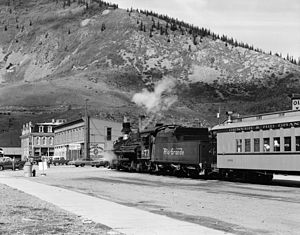- D&RGW K-28
-
Denver & Rio Grande Western
K-28 Class
D&RGW 473 Power type Steam References:[1][2][3] Builder American Locomotive Company (Alco) Build date 1923 Configuration 2-8-2 UIC classification 1′D1′ h Gauge 3 ft (914 mm) Driver diameter 44 in (1,118 mm) Weight on drivers 113,500 lb (51.5 t) Locomotive weight As built:140,000 lb (63.5 t)[1]
Later:156,000 lb (70.8 t)Tender weight 98,500 lb (44.7 t) Fuel type Coal Fuel capacity 16,000 lb (7.3 t) Water capacity 5,000 US gal (19,000 L) Boiler pressure 200 lbf/in² (1.38 MPa) Firegrate area 30.17 sq ft (2.8 m2) Heating surface:
Firebox102 sq ft (9.5 m2) Superheater type Type A Cylinders Two, outside Cylinder size 18 × 22 in (457 × 559 mm) Valve gear Walschaerts Valve type 11-inch (279 mm) piston valves Tractive effort 27,540 lbf (123 kN) Factor of
adhesion4.12 Locomotive brakes Straight air Train brakes No. 6 E-T Career Denver and Rio Grande
Denver and Rio Grande Western
White Pass and Yukon
Durango and SilvertonClass D&RG: 140
D&RGW: K-28Number in class 10 Number 470–479 Nicknames Sports Model Locale Colorado, New Mexico & Alaska Disposition D&SNG:473, 476, 478
Others scrapped after WW2Denver & Rio Grande Western K-28 is a class of ten narrow gauge 2-8-2, Mikado type, steam railway locomotives, built as freight locomotives in 1923 by the Schenectady Locomotive Works of the American Locomotive Company for the Denver & Rio Grande Railroad. They were the first new narrow gauge locomotives ordered by the railroad since 1903.[1] They initially comprised class 190, but were reclassed K-28 in 1924 when the railroad reorganized into the Denver & Rio Grande Western Railroad.[3]
In later years they were tasked with carrying express passengers on the narrow gauge such as the San Juan from Alamosa to Durango, The Silverton from Durango to Silverton and the Shavano from Salida to Gunnison.
Contents
White Pass & Yukon
During World War II, seven of them were taken by the US Army for use on the White Pass and Yukon Route in Alaska and the Yukon. The locomotives which went there were renumbered USA 250–256, worked hard and then scrapped in Seattle after the war. The Durango & Silverton inherited the other three when it took over the Silverton Branch in 1981.[2] Number 473 is operational while 476 is in the Museum at Durango awaiting major repairs, with 478 currently being rebuilt.
The K-28s today
Due to their smaller size, these engines are often used on the Durango & Silverton for shorter trains, usually the first or last on the schedule, and often for helper service or sectioned trains. Despite being smaller than the K-36 class locomotives, a little older and less powerful, the engine crews tend to favor a trip on these engines because the design ALCO used was superior in balance and servicing. Firing can be tricky when the engine is working hard, as the clamshell style firedoors tend to pull into the backhead of the boiler due to the draft, and if any flues in the boiler are leaking, the loss of draft on the fire is much harder to work around than on the K-36 locomotives. Firing while the engine is working hard is done with a large "heel" pattern, generally with as little coal on the flue sheet as possible, and gradually sloping the fire bed towards the door sheet to the height or higher than the firedoors. This results in the draft being forced through the fire bed in the thinner areas towards the flue sheet, which usually is hindered by the lack of draft between the grates and the arch brick. New firemen sometimes have a hard time learning this because there are fewer training hours available on the K-28 class locomotives compared to the railroad's usual K-36 workhorses which have a larger firebox and are more forgiving of poor technique.
Roster[3]
D&RGW
NumberBuilder's
NumberDisposition WP&Y number 470 64981 WP&Y, then scrapped 250 471 64982 WP&Y, then scrapped 251 472 64983 WP&Y, then scrapped 252 473 64984 D&SNG, operational 474 64985 WP&Y, then scrapped 253 475 64986 WP&Y, then scrapped 254 476 64987 D&SNG, museum, awaiting major repair 477 64988 WP&Y, then scrapped 255 478 64989 D&SNG, Currently undergoing rebuild inside Durango roundhouse 479 64990 WP&Y, then scrapped 256 References
- ^ a b c Official Roster No. 11 of the Denver and Rio Grande Western Railroad System. Denver: The Denver and Rio Grande Western Railroad System. April 1, 1923.
- ^ a b "Denver & Rio Grande Western Mikados". Steam Locomotive dot com. http://www.steamlocomotive.com/mikado/drgw.shtml. Retrieved 12 February 2010.
- ^ a b c "Denver & Rio Grande Western Roster". Rio Grande Modeling & Historical Society. http://www.drgw.org/data/steam/roster/drgw04.htm. Retrieved 12 February 2010.
Categories:- Denver and Rio Grande Western Railroad locomotives
- ALCO locomotives
- 2-8-2 locomotives
- United States Army locomotives
- Railway locomotives introduced in 1923
- Narrow gauge steam locomotives of the United States
Wikimedia Foundation. 2010.
